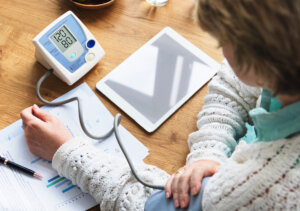Blood Pressure Uncuffed™ Volume 6: 4 Reasons Why You Should Monitor Your Blood Pressure at Home
January 24, 2024. By Sophie Cook
Whether you have hypertension or not, you should be monitoring your blood pressure at home. If you already have high blood pressure (HBP), it’s important to monitor your condition at home to ensure your BP is under control. If you don’t have HBP, it’s still important to regularly self-monitor so that you can catch HBP early, spot trends in your health, help avoid white coat syndrome, and cut down on health care costs.
Catch HBP Early
You could have high blood pressure and not even know it! Hypertension has the nickname “the silent killer” because there are usually no symptoms and the only way to know you have it is to have your BP regularly checked. ~1.28 billion adults worldwide between the ages of 30-79 have hypertension, and only 54% of adults with hypertension are aware of their condition (3). If you regularly monitor your blood pressure at home, you can help catch HBP earlier than if you only get your BP taken twice a year when you visit the doctor (2). The more frequently you take at home readings, the more opportunities to catch fluctuations in your BP, and potentially get faster treatment options (1).
Spot Trends in your Health
Since only ~1 in 5 adults with hypertension have it under control, keeping an eye on your BP with self-monitoring can encourage better control (3). Your blood pressure is likely to fluctuate over the course of the day and can increase or decrease depending on activities. With self-monitoring you can see these trends and possibly even identify anything that triggers a rise in BP (1). Once you’ve dedicated time to monitoring your BP at home, you’ll gain a stronger sense of control over your health.

Is it Really White Coat Syndrome?
A lot of people are affected by something called “white coat syndrome.” White coat syndrome (WCS) usually occurs when nervousness and anxiety builds up while at a medical clinic. This causes an elevated blood pressure reading during the medical exam when you actually have normal blood pressure. The medical professional may take this reading as a sign of high blood pressure instead of white coat syndrome and give you unnecessary treatment options (1).
WCS happens more frequently in the following populations: women, older adults, non-smokers, and pregnant women (4). The opposite of this phenomenon is called “masked hypertension” which is when someone appears to have normal readings at the doctors but has high BP readings at home (2). By regularly monitoring your BP at home you can ensure accurate readings over time that can help determine if you really have high blood pressure, white coat syndrome, or masked hypertension.
Improve your Healthcare
In result from tracking your BP, you may save time and money by having less visits to see your physician. If you are able to consistently monitor your BP at home, you can provide your doctor with a better picture of your health. Recording at least 2 measures a day over time can help your doctor see if lifestyle changes or medications are working as intended (1). With proper self-monitoring you can share your weekly/monthly readings with your doctor to update them on your health and save a trip to the office.
Now that you know why you should start monitoring your BP at home, understanding the proper way to do so is key. To learn how to take a proper BP measure visit our blog here: 4 Steps to Taking a Proper BP measure.
Sources:
- https://www.helloheart.com/post/5-good-reasons-track-blood-pressure-home
- https://www.mayoclinic.org/diseases-conditions/high-blood-pressure/in-depth/high-blood-pressure/art-20047889
- https://www.who.int/news-room/fact-sheets/detail/hypertension
- https://www.ahajournals.org/doi/full/10.1161/hypertensionaha.113.01275?s2=P875439243_1683331208357621068